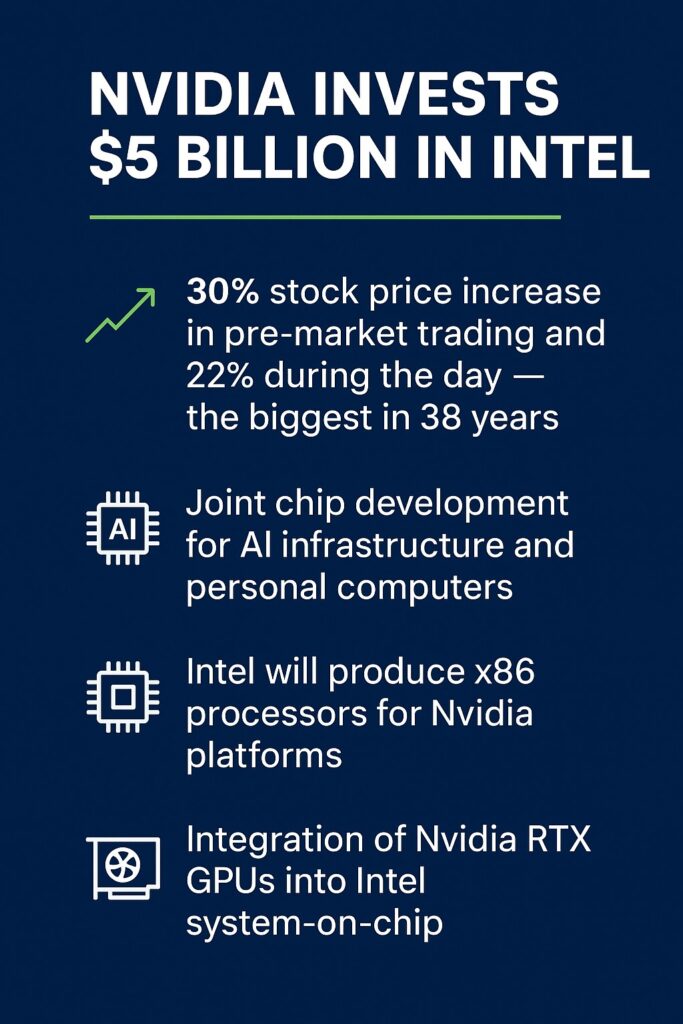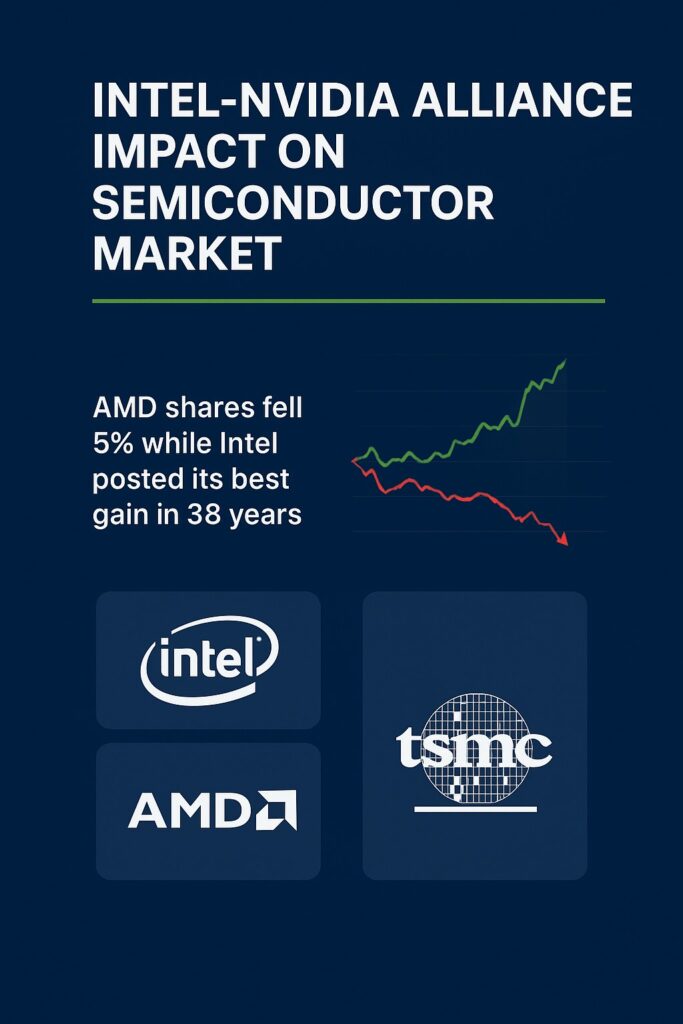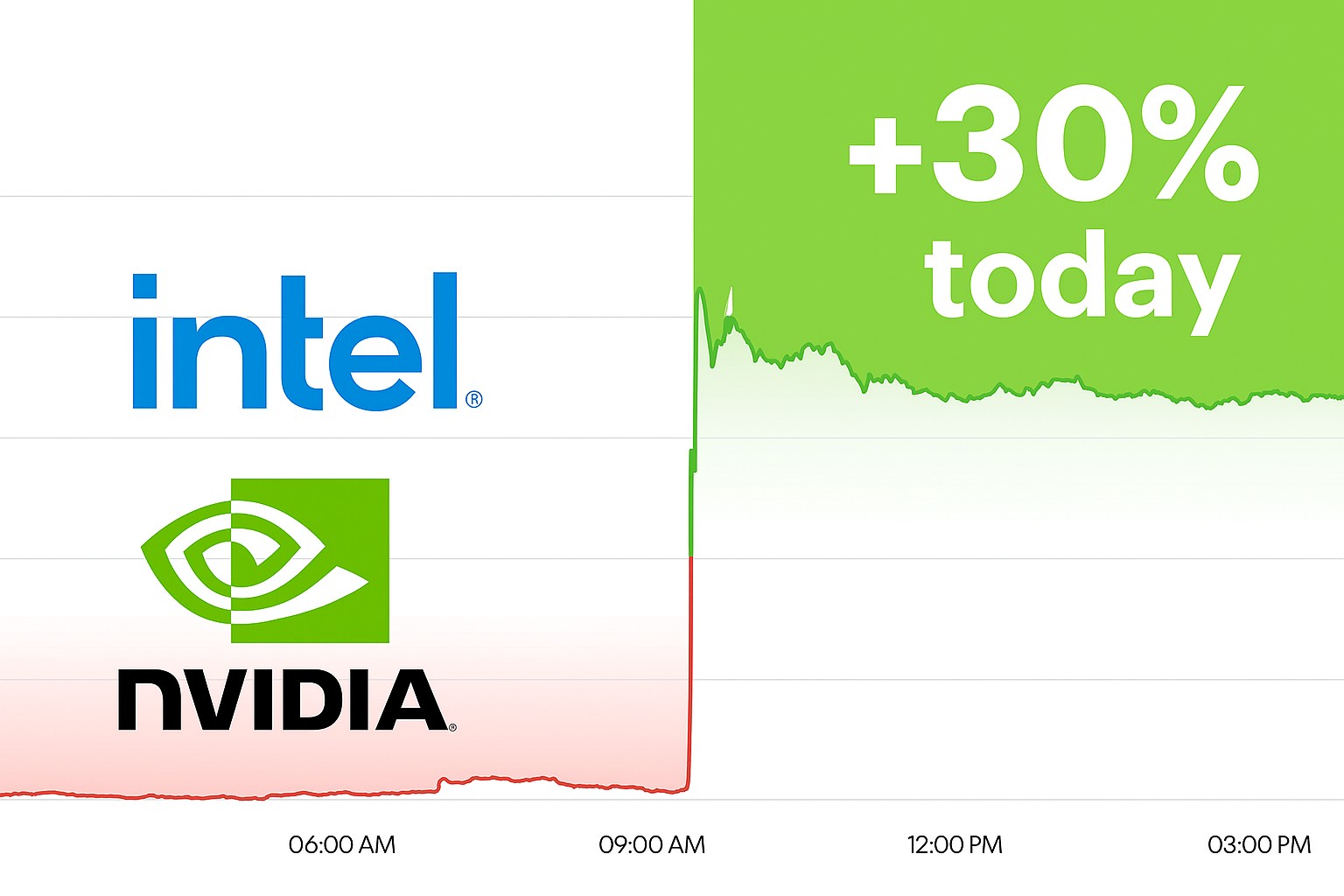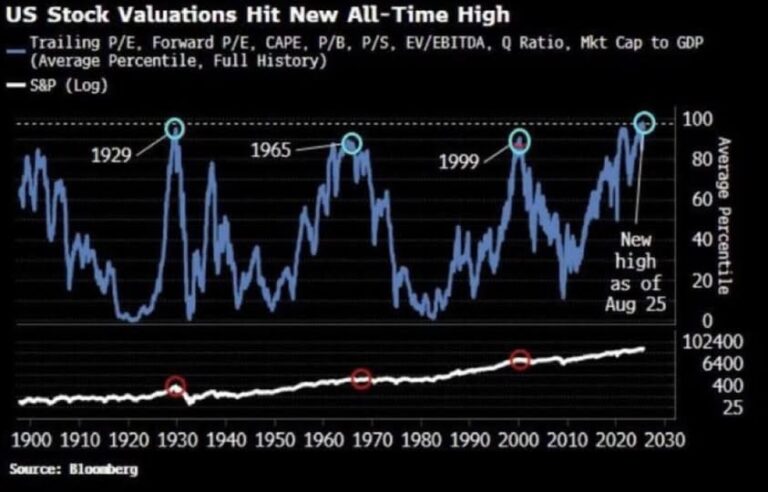Historic Intel and Nvidia Partnership: A New Era in the Semiconductor Industry
The technology world has witnessed one of the most unexpected and significant deals of the past decade. On September 18, 2025, Nvidia and Intel, former competitors, announced an unprecedented partnership that will not only redraw the semiconductor market map but may also define the future of artificial intelligence and personal computers for years to come. Nvidia’s $5 billion investment in Intel triggered a real earthquake in the stock markets, lifting Intel shares by a record 30% in pre-market trading and 22% by the end of the trading day – the company’s largest single-day gain in 38 years.
Key Partnership Points
The collaboration between the two tech giants covers several critically important areas. First, for data centers, Intel will develop custom x86 processors for Nvidia’s AI infrastructure platforms. This means that Nvidia’s most powerful artificial intelligence solutions will now receive processors optimized for their needs from Intel, which should provide unprecedented performance and energy efficiency.

Second, for the personal computer market, Intel will create and offer x86 systems-on-chip (SOCs) that will integrate Nvidia RTX GPU chiplets. This is a revolutionary step that combines Intel’s best processor technologies with Nvidia’s advanced graphics solutions in a single chip. Such integration promises a new level of performance for gaming systems, workstations, and laptops.
The financial component of the deal is no less impressive. Nvidia will purchase Intel shares at $23.28 per share, giving the company approximately a 4% stake in Intel after the new shares are issued. This makes Nvidia one of Intel’s largest shareholders, alongside the U.S. government, which recently acquired a 10% stake in the company for $8.9 billion.
Impact on Intel: From Crisis to Revival
For Intel, this partnership has become a true lifeline during the most difficult period in its history. The company, which dominated the processor market for decades, has faced unprecedented challenges in recent years. Losses of $19 billion last year and another $3.7 billion in the first six months of this year forced management to announce a reduction of a quarter of the workforce by the end of 2025.
Nvidia’s investment and the prospect of close cooperation with the AI chip market leader instantly changed investor sentiment. Intel shares, which were trading at historic lows at the beginning of the year, rose 52% year-to-date after the partnership announcement, with the company’s market capitalization reaching $143 billion. This is the company’s best stock performance since 1987, demonstrating enormous market faith in the potential of this collaboration.
The partnership will also allow Intel to fully utilize its manufacturing capabilities and expertise in x86 architecture development. Instead of fighting Nvidia for the AI accelerator market, Intel will now become a key partner in creating comprehensive artificial intelligence solutions.
Strategic Advantages for Nvidia
For Nvidia, a company with a market capitalization of over $4.2 trillion, this partnership opens new horizons for growth. First, gaining access to Intel’s manufacturing capabilities and technologies will help Nvidia diversify its supply chains amid geopolitical tensions between the U.S. and China.
Second, the integration of Intel processors with Nvidia GPUs will create synergies that will allow the company to offer comprehensive “all-in-one” solutions for data centers and personal computers. This is especially important in the context of growing demand for AI computing, where optimizing CPU-GPU interaction can significantly increase overall system performance.
Nvidia shares also reacted positively to the news, rising 3.5%, adding tens of billions of dollars to its market value. Investors see this partnership as an opportunity for Nvidia to further strengthen its position in the AI chip market and expand its presence in the personal computer segment.
Implications for Competitors and the Industry
The Intel and Nvidia partnership creates a powerful alliance that changes the balance of power in the semiconductor industry. AMD suffered the most from this news – the company’s shares fell 5% immediately after the announcement. AMD, which successfully competed with both Intel in the processor market and Nvidia in the graphics card market, now finds itself facing a united front of two giants. By the way, I have AMD shares in my portfolio.

For TSMC, the world’s largest contract chip manufacturer, this partnership creates a complicated situation. On one hand, Nvidia continues to work with TSMC to manufacture its most advanced GPUs on 3-nanometer and future 2-nanometer processes. Nvidia CEO Jensen Huang confirmed that the company remains committed to its ARM roadmap and cooperation with TSMC. On the other hand, the deepening relationship between Nvidia and Intel could, in the long term, reduce Nvidia’s dependence on the Taiwanese manufacturer, especially given the geopolitical risks in the region.
Qualcomm, which is actively developing its ARM processors for PCs and mobile devices, also finds itself under pressure. The integration of Intel x86 processors with Nvidia GPUs creates a powerful alternative to Qualcomm Snapdragon solutions for laptops and tablets. This is especially critical in the AI PC segment, where Qualcomm has been trying to gain market share with its energy-efficient chips.
ARM Holdings, the British company that develops processor architecture, will also face new challenges. While Nvidia continues to develop its ARM-based Grace processors, the partnership with Intel may mean increased investment in the x86 ecosystem. This could potentially slow ARM architecture’s penetration into data centers and high-performance computing.
Broadcom, a key player in networking chips and AI accelerators, may find itself in a difficult position. The company competes with Nvidia in the custom AI chip segment for hyperscalers, and will now have to face the combined resources of Intel and Nvidia.
For the entire industry, this partnership signals a new era of cooperation instead of competition. As advanced chip development becomes increasingly expensive and complex, even the largest players understand the need to join forces. This is especially relevant in the context of global competition with Chinese chip manufacturers and the need to maintain U.S. technological leadership.
Consumers also benefit from this partnership. The integration of the best technologies from Intel and Nvidia promises the emergence of a new generation of devices with unprecedented performance and energy efficiency. From powerful AI servers to ultra-thin laptops with gaming and content creation capabilities – all market segments will gain access to innovative solutions.
The Future of the Partnership
While specific technical details and release dates for the first products have not yet been announced, both companies emphasize the long-term nature of the collaboration, which will span “multiple generations” of products. This means we can expect the first joint developments as early as next year, with further evolution and improvement of technologies over the coming years.
The partnership also has important geopolitical significance. In the context of technological competition between the U.S. and China, the joining of forces by two American technology leaders strengthens the country’s position in the global race for leadership in artificial intelligence and semiconductors.
Conclusion
The Intel and Nvidia partnership is more than just a business deal. It’s a fundamental paradigm shift in the semiconductor industry, where cooperation replaces competition to achieve joint technological breakthroughs. The rapid 30% rise in Intel shares after the announcement is just the beginning of a transformation that could reformat the entire technology ecosystem.
For investors, this partnership creates unique opportunities. Intel, which yesterday looked like a company in crisis, today has a clear path to recovery and growth. Nvidia confirms its status not just as a chip manufacturer, but as an architect of the future of computing technology.
In an era where artificial intelligence is becoming the foundation of technological progress, combining Intel’s processor expertise with Nvidia’s GPU leadership creates a platform for the next generation of innovation. From autonomous vehicles to quantum computing, from the metaverse to personalized medicine – all these technologies of the future will now receive a powerful boost from the synergy of two technological titans.
Read in Ukrainian: “Історичне партнерство Intel та Nvidia: Нова ера в індустрії напівпровідників“.






